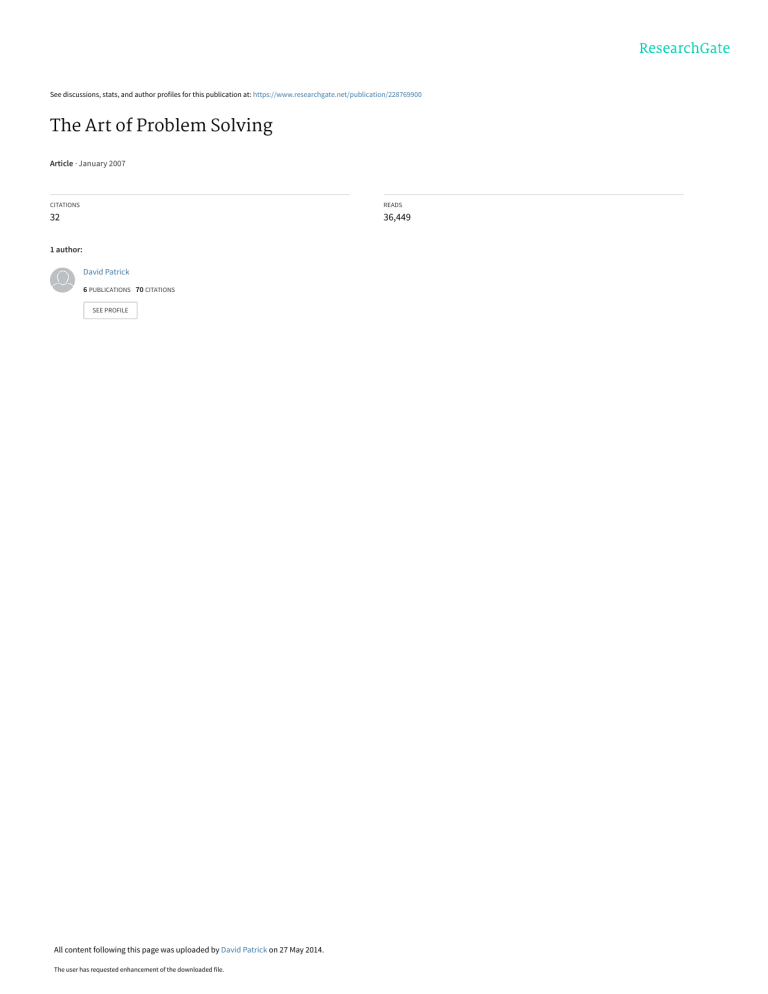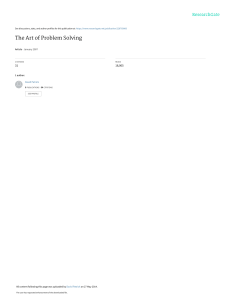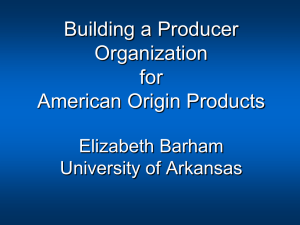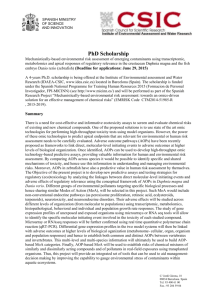
See discussions, stats, and author profiles for this publication at: https://www.researchgate.net/publication/228769900 The Art of Problem Solving Article · January 2007 CITATIONS READS 32 36,449 1 author: David Patrick 6 PUBLICATIONS 70 CITATIONS SEE PROFILE All content following this page was uploaded by David Patrick on 27 May 2014. The user has requested enhancement of the downloaded file. Mathematics Competitions Vol 20 No 1 2007 The Art of Problem Solving David Patrick David Patrick is Vice President of AoPS Incorporated. He is the author of Introduction to Counting & Probability, a discrete math textbook for middle and high school students, and is currently working on the sequel, Intermediate Counting & Probability. He was a USA Mathematical Olympiad winner in 1988, earned his Ph.D. in Mathematics from MIT in 1997, and did research in noncommutative algebra. 1 History The Art of Problem Solving (AoPS) website,1 established in 2003, has grown to over 29,000 members.2 We believe that it is the largest website of its kind in the English-speaking world, with mathematics resources developed specifically for high-ability middle and high school students. AoPS has been called “a revolution in mathematics training for the top high school students.” [3] 2 Forum, Blogs, and Wiki The heart of AoPS is the AoPS Forum, which has over 800,000 posts on a variety of topics, mathematical and otherwise. The AoPS Forum is for students, parents, and teachers to discuss various math problems 1 http://www.artofproblemsolving.com 2 All statistics cited in this article are as of 4 May 2007. 19 Mathematics Competitions Vol 20 No 1 2007 and other topics of interest to people interested in math. The Forum is free for everyone, and its members are students and teachers from all different ages, locations, and abilities. In the late afternoon of May 4, 2007, the list of recent discussions include the following (note that these are the actual discussion titles as they appear on the AoPS Forum, so the titles may include misspellings): – Maximum of minimum of a i n 1 + i=1 i (in the Olympiad Inequalities forum; the forum is LATEX-compatible to allow for mathematical discussion) – “Another TC problem, whose solution I don’t understand” (in the Computer Science and Informatics forum) – “baseball” (in the Middle School forum; the problem under discussion was a middle-school level problem about baseball) – “Nysml” (in the New York local forum; the discussion was about the recently-concluded New York State Mathematics League contest) – “Displaying the power of a matrix” (in the College Linear Algebra forum) – “perfect square in different bases” (in the High School Basics forum) All of the posts listed (and many others not listed) occurred in a span of under 20 minutes. Any AoPS member can set up his or her own personal blog, which is a personal web page on which the owner can post anything he or she wishes. Although the subjects on the blog are unrestricted, many of the blog entries discuss mathematics and problem solving. Currently, over 750 AoPS users have started blogs. Finally, AoPS has started a wiki about mathematics and problem solving. A wiki is an online encyclopedia that can be edited by anyone. The AoPS wiki has over 2,000 articles on a variety of topics: some are related to mathematical ideas and concepts, others are related to problems and/or problem solving technique, and still others point to other resources. To give a flavor for the types of articles in the AoPS wiki, a list of some of the most recently created or edited articles includes: 20 Mathematics Competitions Vol 20 No 1 2007 – Fermat’s Last Theorem – Pascal’s Triangle Related Problems – 2007 USAMO Problems – The Art and Craft of Problem Solving 3 – Asymptote4 – 1997 AIME Problems 3 Online Classes AoPS runs a number of online classes specifically designed for strong students in grades 7–12. All of the classes are conducted in AoPS’s “virtual classroom,” an online, moderated chatroom that is LATEXcompatible and graphics-enabled, to permit mathematical discussion. AoPS offers three different types of classes. First are subject classes in traditional secondary school math topics: algebra, counting & probability, geometry, number theory, and trigonometry. These classes tend to be similar in content to a traditional in-school class, but with a much greater emphasis on difficult problem solving. Second are classes that are designed as preparation for one of the major US mathematics competitions, such as MATHCOUNTS and the various American Mathematics Competitions (AMC) contests (the AMC contests are those that eventually lead to the selection of the United States IMO team). Finally, AoPS offers a year-long Worldwide Online Olympiad Training (WOOT) program, designed for the very best students whose ambition is to do problem-solving at the IMO level. To give some indication of the quality of the WOOT students, in 2005-06 over 90% of the US students in WOOT qualified for the 2006 USA Mathematical Olympiad, which is very selective: of the approximately 230,000 students in 2006 who wrote one of the initial AMC contests, only 430 qualified for the USAMO. [1] 3 This is a popular problem-solving textbook, authored by former IMO participant Paul Zeitz. 4 Asymptote is a L AT X plug-in for creating high-quality diagrams. The Asymptote E wiki pages on AoPS are considered the “official” wiki pages of the Asymptote project. 21 Mathematics Competitions Vol 20 No 1 2007 4 AoPS Foundation and USA Math Talent Search Separate from the main AoPS website is the Art of Problem Solving Foundation5 . The AoPS Foundation’s mission is to promote problem solving education for middle and high school students in the United States. The Foundation supports two major endeavors. USA Mathematical Talent Search The USAMTS was founded in 1989 by George Berzsenyi at the RoseHulman Institute of Technology. It has run annually every year since, and after a number of years of being managed by the US National Security Agency, the management of the contest was passed to the AoPS Foundation in 2004. The USAMTS runs during the USA school year (roughly September through April), and consists of 4 rounds of 5 questions each. The USAMTS is a “take-home” contest and is run entirely via the http://www.usamts.org website. Students have at least one full month to work on each round of problems, and must write and submit full solutions including proofs. Students are permitted to use any available resource to solve the problems, including books, calculators, and computers, but may not consult with teachers or other students. Another unique feature of the USAMTS is that students not only receive numeric scores on their solutions, but also receive written feedback on both the correctness and the writing style of their submitted work. The problems on Round 1 of the 2006-07 USAMTS were: 1. When we perform a ‘digit slide’ on a number, we move its units digit to the front of the number. For example, the result of a ‘digit slide’ on 6471 is 1647. What is the smallest positive integer with 4 as its units digit such that the result of a ‘digit slide’ on the number equals 4 times the number? 5 http://www.artofproblemsolving.org 22 Mathematics Competitions Vol 20 No 1 2007 2. (a) In how many different ways can the six empty circles in the diagram at right be filled in with the numbers 2 through 7 such that each number is used once, and each number is either greater than both its neighbors, or less than both its neighbors? (b) In how many different ways can the seven empty circles in the diagram at right be filled in with the numbers 2 through 8 such that each number is used once, and each number is either greater than both its neighbors, or less than both its neighbors? 3. (a) An equilateral triangle is divided into 25 1 congruent smaller equilateral triangles, as shown. Each of the 21 vertices is labeled with a number such that for any three consecutive vertices on a line segment, their labels form an arithmetic sequence. The vertices of the original equilateral triangle 4 are labeled 1, 4, and 9. Find the sum of the 21 labels. 1 1 9 (b) Generalize part (a) by finding the sum of the labels when there are n2 smaller congruent equilateral triangles, and the labels of the original equilateral triangle are a, b, and c. 4. Every point in the plane is colored either red, green, or blue. Prove that there exists a rectangle in the plane such that all four of its vertices are the same color. 5. ABCD is a tetrahedron such that AB = 6, BC = 8, AC = AD = 10, and BD = CD = 12. Plane P is parallel to face ABC and divides the tetrahedron into two pieces of equal volume. Plane Q is parallel to face DBC and also divides ABCD into two pieces of equal volume. Line is the intersection of planes P and Q. Find the length of the portion of that is inside ABCD. 23 Mathematics Competitions Vol 20 No 1 2007 Local Programs The AoPS Foundation also supports a number of local programs devoted to mathematics and problem solving education in specific communities around the United States. These include a number of Math Circles, including those in San Diego, Stanford, Boulder (Colorado), Charlotte, San Jose, Orange County (California), and Albany (New York). The AoPS Foundation also supports The Teachers’ Circle, a new math circle designed specifically for teachers in the San Francisco Bay area. The Teachers’ Circle is described in greater detail in [2]. References [1] 2006 Summary of High School Results and Awards, American Mathematical Competitions, Mathematical Association of America, 2006. [2] T. Shubin, “Math Circles for Students and Teachers,” Mathematics Competitions, 19 #2, 2006. [3] M. Matchett Wood, “Art of Problem Solving: A New Resource for Outstanding Mathematics Students,” MAA Focus, 27 #3, March 2007. David Patrick AoPS Incorporated Alpine, California, USA Email: patrick@artofproblemsolving.com 24 View publication stats




